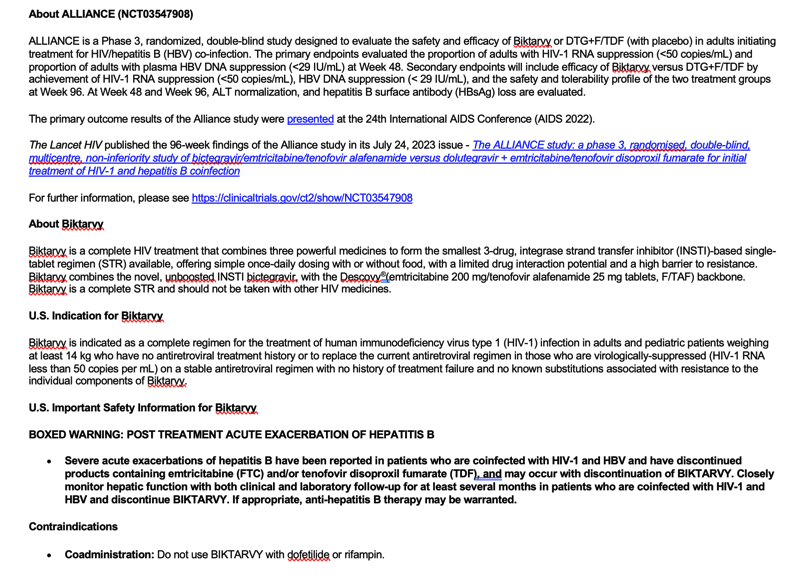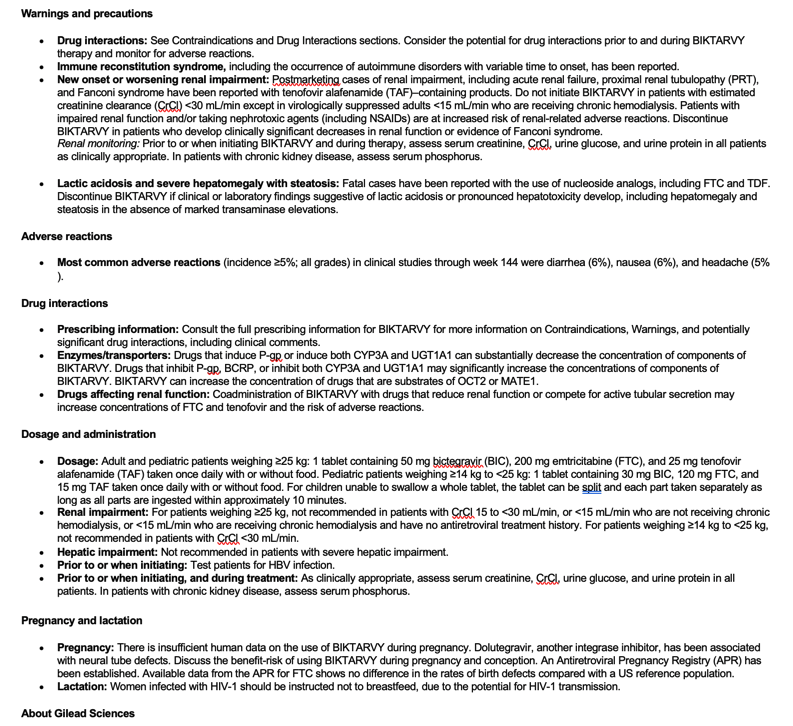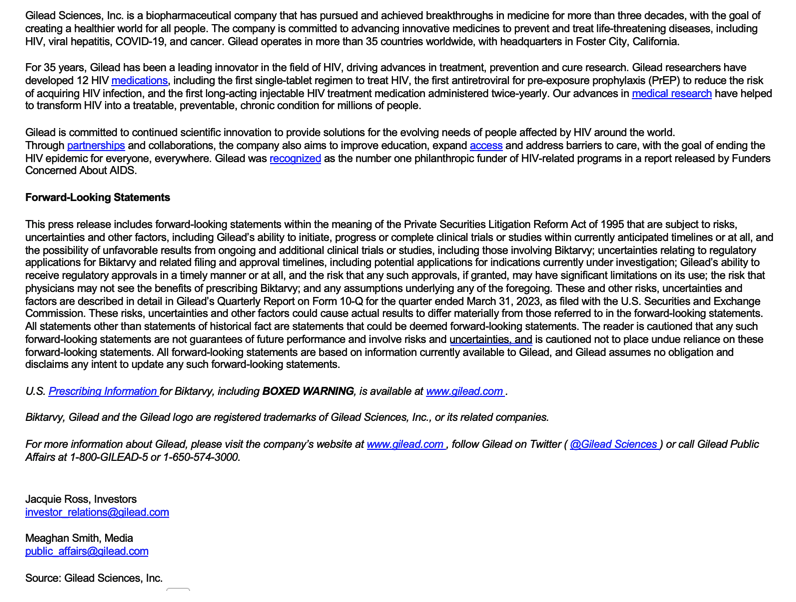 |
 |
 |
| |
New Biktarvy® Data Presented at IAS 2023 Further Demonstrate Safety and Efficacy Profile in a Broad Range of People and Communities Affected by the Global HIV Epidemic
Press Releases
|
| |
| |
July 23, 2023
- Biktarvy Evaluated in a Diverse Range of People With HIV, Including Pregnant Women and Pediatric Populations -
- 96-Week Data from ALLIANCE Trial Show Durability of Biktarvy in Adults With HIV and HBV
Coinfection -
FOSTER CITY, Calif.--(BUSINESS WIRE)-- Gilead Sciences, Inc. (Nasdaq: GILD) today announced results from multiple studies reinforcing Biktarvy®(bictegravir 50 mg/emtricitabine 200 mg/tenofovir alafenamide 25 mg tablets, B/F/TAF) as a treatment option for a broad range of people with HIV. The latest findings include key insights into the treatment of virologically suppressed pregnant women and children two years of age or older (weighing at least 14 kg to less than 25 kg) and positive Week 96 data from the ALLIANCE trial in adults with HIV/hepatitis B (HBV) coinfection who were initiating therapy. The data were presented at the 12th International AIDS Society (IAS) Conference on HIV Science (IAS 2023), taking place July 23-26 in Brisbane, Australia.
Pregnant Women with HIV
In an open-label study evaluating the pharmacokinetics, safety, and efficacy of switching to once-daily Biktarvy in virologically suppressed pregnant women with HIV, Biktarvy was generally well tolerated and all participants maintained virologic suppression at delivery (HIV-1 RNA <50 copies/mL; n=32). Moreover, no cases of perinatal HIV transmission were observed. No adverse events (AEs) leading to premature discontinuation and no drug-related AEs were observed in the pregnant women or neonates. These results suggest Biktarvy may be an appropriate treatment option during pregnancy with no dose change required.
"This study demonstrates the potential role of B/F/TAF as a treatment of HIV in pregnant women, a population that has historically been difficult to study and that continues to have significant needs," said Anchalee Avihingsanon, MD, PhD, Senior Researcher, HIV-NAT, Thai Red Cross AIDS Research Center, Thailand. "The clinical profile of Biktarvy is further supported by safety data and no mother-to-child transmission in this study and data showing that normal dosing may be appropriate. These are important findings for pregnant women and their healthcare providers when considering HIV treatment."
Pediatric HIV
Additional Biktarvy data presented at IAS 2023 included an analysis of two ongoing, open-label studies evaluating the weight, height, body mass index (BMI) and lipid metabolism parameters of virologically suppressed children with HIV (81.6% Black; aged ≥2 years and weighing 14 to <25 kg) who switched to Biktarvy (n=22) or elvitegravir/cobicistat/emtricitabine/tenofovir alafenamide (E/C/F/TAF; n=27). At Week 48, the proportion of participants who were underweight decreased from 20.4% to 14.3%, while the proportion of normal weight participants increased from 67.3% to 73.5%, respectively. Meanwhile, the proportion of overweight or obese participants remained stable at 12.2%. Overall, lipid metabolism parameters generally improved during 48 weeks of treatment. Presently, children with HIV must be on antiretroviral therapy for their entire lives. This underscores the importance of studying the impacts of treatment on weight, height, body mass index and lipid parameters in this young age group.
"It is important that we limit the potential for weight and metabolic changes as a result of antiretroviral treatment in young children with HIV," said Eva Natukunda, MD, Head of Department of Pediatrics, Joint Clinical Research Centre, Uganda. "In this study, the results of the TAF-based regimens further reinforce the role of these regimens as an appropriate treatment option for this population."
In October 2021, the U.S. Food and Drug Administration (FDA) approved a low-dose tablet dosage form of Biktarvy for pediatric patients weighing at least 14 kg to less than 25 kg who are virologically suppressed or new to antiretroviral therapy. In the EU, Biktarvy is authorized for the treatment of HIV infection in adults and pediatric patients at least 2 years of age and weighing at least 14 kg without present or past evidence of viral resistance to the integrase inhibitor class, emtricitabine or tenofovir.
HIV/HBV Coinfection
ALLIANCE is an ongoing Phase 3 study evaluating Biktarvy versus dolutegravir 50 mg (DTG) + emtricitabine 200 mg/tenofovir disoproxil fumarate 300 mg, F/TDF, DTG+F/TDF, in adults with HIV-1/HBV co-infection initiating treatment. The Week 96 results demonstrated the efficacy of both antiretroviral regimens. Participants who initiated treatment with Biktarvy (n=121) or DTG+F/TDF (n=122) had similarly high and sustained rates of viral suppression. These data, combined with the lower impact of TAF versus TDF on bone and renal parameters, show clinical benefits of Biktarvy for adults with both HIV-1 and HBV initiating antiviral therapy.
The Week 96 results show numerically higher levels of hepatitis B viral suppression (HBV DNA <29 IU/mL) with Biktarvy (75% vs. 70%; 95% CI - 8.3%,13.4%, p=0.64). Importantly, participants who initiated treatment with Biktarvy had numerically higher alanine aminotransferase (ALT) normalization (72% vs 57%, p=0.13) and hepatitis B surface antigen loss (23% vs. 14%, p=0.066) and seroconversion (9% vs. 7%, p=0.44). Expectedly, participants who initiated treatment with Biktarvy or DTG+F/TDF also had high rates of HIV suppression (HIV-1 RNA <50 copies/mL) at Week 96 (87% vs. 88%; 95% CI - 8.9% to 8.3%, p=0.94) with mean CD4 cell count increases of 261 and 229 cells/μl from baseline, respectively. Beyond Week 96, select participants will be able to receive Biktarvy in an open-label extension phase for up to 48 weeks.
Further results from the trial showed that safety findings were similar between the Biktarvy and DTG+F/TDF groups. Adverse events (AEs) included upper respiratory tract infection (19.8% vs. 14.8%), COVID-19 (38% vs. 36.1%), pyrexia (12.4% vs. 13.1%), ALT increase (8.3% vs. 12.3%), and nasopharyngitis (12.4% vs. 6.6%).
"Gilead is committed to the treatment of HIV in a broad range of people with diverse health needs, which is a cornerstone of our global efforts to help end the epidemic," said Jared Baeten, MD, PhD, Vice President, HIV Clinical Development, Gilead Sciences. "These studies build on our understanding of Biktarvy and its role in helping people affected by HIV by providing clinically relevant treatment data for pregnant women, children and those living with comorbidities like HBV."
The use of Biktarvy in individuals with HIV/HBV co-infection is investigational and the safety and efficacy of this use have not been established.
Please see below for U.S. Indications and Important Safety Information, including Boxed Warning on post treatment acute exacerbation of hepatitis B, for Biktarvy.
There is currently no cure for HIV or AIDS.



|
| |
|
 |
 |
|
|